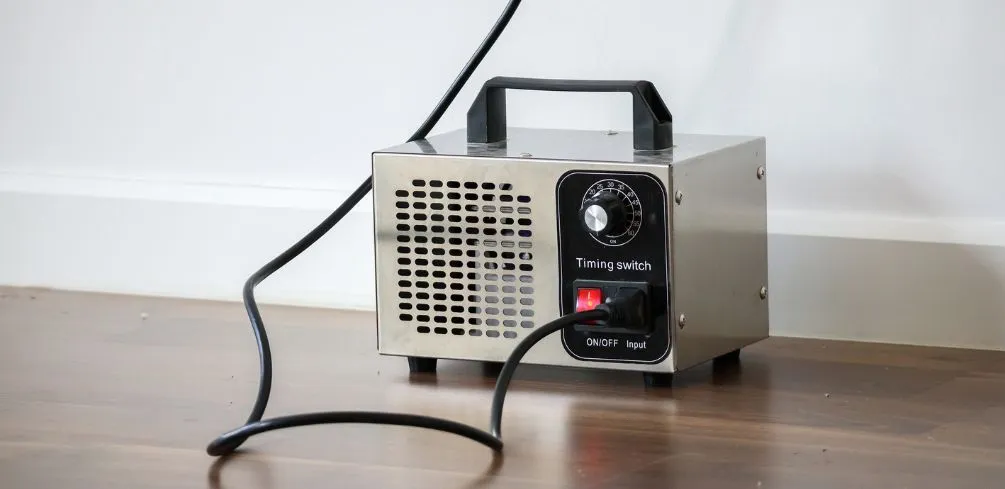Ozone generators are a great way to keep your home fresh and clean, but did you know they can also be used in the home? Ozone is an effective tool for cleaning up odors and purifying the air.
When used correctly, ozone generators can help reduce allergens, bacteria, mold spores, and other airborne pollutants. This article will explain what an ozone generator is and how to use it safely in the home. We’ll cover common uses for these devices as well as best practices when using them at home.
Finally, we’ll provide troubleshooting tips if any issues arise with your ozone generator so you can get back on track quickly! Use of an ozone generator in the home requires knowledge about safety protocols – this guide has all of the information you need!
What is an Ozone Generator?
An ozone generator is a device that produces ozone, which is an unstable form of oxygen. Ozone has the ability to purify air and water, as well as eliminate odors and bacteria.
It can be used in many different settings, including homes, offices, hospitals, and industrial sites.
What Do Ozone Machines Do?
Ozone Machines produce ozone by breaking down oxygen molecules into single atoms with electricity or ultraviolet light. These single atoms then combine with other oxygen molecules to create ozone (O3).
This process is known as oxidation and it’s what gives ozone its unique properties for cleaning air and surfaces. The amount of ozone produced depends on the type of generator being used; some generate more than others.
Benefits of Using an Ozone Generator
The primary benefit of using an ozone generator is its ability to remove odors from indoor spaces quickly and effectively without the use of harsh chemicals or fragrances. In addition to odor removal, they can also help reduce allergens such as dust mites and mold spores in the air by oxidizing them out of existence when exposed to high levels of ozone concentration gas.
Additionally, they are often used for sanitizing surfaces like countertops or floors because their strong oxidizing power kills off harmful bacteria on contact while leaving behind no residue or smell after use.
Types Of Ozone Generators
There are two main types of ozone generators: corona discharge (CD) generators and ultraviolet (UV) generators.
CD generators work by passing a current through electrodes, which creates charged particles called ions that break apart oxygen molecules into single atoms before recombining them back together again into ozonated oxygen (O3).
UV generators operate similarly but rely on ultraviolet light instead of electrical currents to achieve the same result. Both types are effective at producing large amounts of clean-smelling air in short periods of time, though UV models tend to be quieter since there is no electric current running through them during operation.
Ozone generators can be a great addition to any home as they provide many benefits. Knowing what an ozone generator is and the different types available can help you decide which one best fits your needs. Next, let’s take a look at what an ozone generator does and its benefits.
Takeaway: Ozone generators are a great way to remove odors, allergens, and bacteria from indoor spaces without the use of harsh chemicals or fragrances. There are two main types of ozone generators: corona discharge (CD) and ultraviolet (UV). CD generators create charged particles that break apart oxygen molecules into single atoms before recombining them back together again into ozonated oxygen. UV generators rely on ultraviolet light instead of electrical currents to achieve the same result. Both types are effective at producing large amounts of clean-smelling air in short periods of time, though UV models tend to be quieter since there is no electric current running through them during operation.
How to Use an Ozone Generator in the Home
Safety Precautions When Using an Ozone Generator:
When using an ozone generator, it is essential to take safety precautions. It is recommended that you wear protective gear such as gloves and a face mask when handling the device.
Additionally, make sure that all pets and people are out of the room while operating the machine. Keep windows open in order to ensure proper ventilation during use.
Lastly, do not operate the ozone generator for more than four hours at a time, as prolonged exposure can be hazardous to your health.
Steps for Setting Up and Operating an Ozone Generator:
Before setting up your ozone generator, read through the user manual thoroughly so you understand how it works properly. Make sure that all electrical connections are secure before plugging in the machine.
Once plugged in, set up any timers or automated systems needed to control usage time if desired. Place the ozone generator away from furniture or other objects that may be affected by its operation and turn it on according to instructions given in the user manual.
After use has been completed, unplug immediately and allow room to ventilate for at least 30 minutes before re-entering the space again safely with protective gear if necessary.
Maintenance Tips for Your Ozone Generator:
Regular maintenance of your ozone generator will help keep it running efficiently over time and extend its lifespan significantly. Check filters regularly (every six months) and replace them as needed depending on usage frequency; this helps prevent dust particles from entering the system, which could cause damage over time if left unchecked.
Clean off any dirt or debris buildup around vents with a damp cloth every few weeks; this ensures proper airflow throughout the system, which allows the unit to run optimally without interruption due to clogged vents.
Finally, check electrical connections periodically (every three months) to make sure they are still secure; loose wires can lead to the malfunctioning of the device, so checking these often is highly recommended.
Using an ozone generator in the home can help to improve air quality, but it is essential to take necessary safety precautions and properly maintain your device. Next up, we’ll discuss diffusers and humidifiers and how they can benefit your home environment.
Takeaway: When using an ozone generator, it is important to take safety precautions, such as wearing protective gear and ensuring all people and pets are out of the room while operating. Setting up and operating the device should be done according to the instructions in the user manual. Regular maintenance, such as checking filters, cleaning vents, and inspecting electrical connections, can help keep your ozone generator running efficiently over time.
Common Uses for an Ozone Generator in the Home
Ozone is a powerful oxidizer that can be used to remove odors, purify the air, and sanitize surfaces and objects. It’s important to understand how an ozone generator works and what it can do before using one in your home.
Odor Removal and Air Purification: Ozone is an effective odor remover because it reacts with organic molecules like those found in smoke, pet dander, mold spores, bacteria, viruses, and other pollutants. When ozone comes into contact with these particles it breaks them down into harmless compounds such as oxygen or carbon dioxide.
This process not only eliminates odors but also improves indoor air quality by removing harmful contaminants from the air you breathe.
Sanitizing Surfaces and Objects in the Home: Ozone has been proven to kill 99% of germs on hard surfaces when used correctly. This makes it ideal for sanitizing countertops, sinks, toilets, floors, etc., as well as toys or other items that may have come into contact with germs or bacteria during daily use.
It’s important to note that ozone should never be used directly on people or animals due to its potential health risks if inhaled over long periods of time at high concentrations.
Improving Indoor Air Quality: Ozone is also known for its ability to reduce levels of volatile organic compounds (VOCs), which are common indoor pollutants found in paint fumes, cleaning products, and more. By reducing VOC levels you can help improve overall indoor air quality while simultaneously eliminating unpleasant odors caused by these chemicals from entering your living space.
It is important to remember that when using an ozone generator, safety must always come first. Therefore, it is essential to follow all instructions provided by the manufacturer carefully, including proper ventilation requirements, before use.
Ozone generators can be a great tool to help improve the air quality in your home while also providing an effective way to remove odors and sanitize surfaces. Now let’s look at how you can use a fog machine, humidifier, or diffuser to further enhance the environment of your home.
Takeaway: Ozone generators can be used to improve the air quality in your home by removing odors, purifying the air, and sanitizing surfaces and objects. However, it is important to use them safely by following all instructions provided by the manufacturer carefully and ensuring proper ventilation before use. Key takeaways: – Ozone reacts with organic molecules like smoke, pet dander, mold spores etc., breaking them down into harmless compounds – Eliminates odors and improves indoor air quality – Kills 99% of germs on hard surfaces when used correctly – Reduces levels of volatile organic compounds (VOCs) – Must follow manufacturer instructions for safe use.
Best Practices for Using an Ozone Generator in the Home
Using an ozone generator in the home can be a great way to improve air quality and remove odors. However, it is important to use these devices safely and responsibly.
Here are some best practices for using an ozone generator in the home:
Ventilating the Room Properly Before and After Use: It is essential that you properly ventilate any room where you plan on using an ozone generator. This means opening windows or doors before turning on your device, as well as allowing plenty of time after the usage for fresh air to circulate throughout the space.
Additionally, make sure that all people and pets have left the area prior to activating your machine.
Using a Timer or Automated System to Control Usage Time: Ozone generators should not be used continuously over long periods of time, so it’s important to set up a timer or automated system that will turn off your device after a certain amount of time has passed. Most machines come with this feature built-in but if yours does not then you can purchase one separately from most hardware stores or online retailers.
Monitoring the Levels of Ozone Generated During Use: It is also important to monitor how much ozone is being generated during use by checking levels with an appropriate meter every few minutes while running your machine (most models come with this feature). If levels become too high then shut off your device immediately until they return back down within safe limits.
By following these simple guidelines when using an ozone generator in the home, you can ensure that everyone remains safe while enjoying improved air quality and odor removal benefits. Ensure that all people and pets are out of the room during operation, turn off any fans or other ventilation systems, keep windows closed, and leave the area for at least 30 minutes after use.
Additionally, be sure to set up your ozone generator according to manufacturer instructions and never exceed recommended levels of ozone concentration.
By following the best practices outlined above, you can ensure that using an ozone generator in your home is safe and effective. Now let’s look at the benefits of using a diffuser or humidifier to help create a healthier environment in your home.
Takeaway: When using an ozone generator in the home, it is important to follow safety guidelines to ensure everyone remains safe and enjoys improved air quality. These include: ventilating the room properly before and after use; setting up a timer or automated system to control usage time; monitoring levels of ozone generated during use; turning off any fans or other ventilation systems; keeping windows closed; leaving the area for at least 30 minutes after use.
Troubleshooting Common Issues with Your Ozone Generator
Troubleshooting Common Issues with Your Ozone Generator can be a daunting task, but it doesn’t have to be. With the right information and some basic troubleshooting steps, you can quickly identify and fix any issues that may arise with your ozone generator.
Checking Electrical Connections and Power Supply: The first step in troubleshooting an ozone generator is to check all electrical connections and power supply. Make sure all wires are securely connected, the power switch is on, and the outlet is working properly.
If there are any loose or damaged wires, replace them immediately before continuing with other troubleshooting steps.
Cleaning or Replacing Filters as Needed: Another important step in maintaining your ozone generator is to clean or replace filters as needed. Depending on how often you use your machine, this could mean every few months or more frequently if necessary.
To clean filters, simply remove them from the unit and rinse off any dirt or debris using warm water and mild soap, then let the air dry completely before reinstalling them back into place. If they appear worn out or damaged beyond repair it’s best to replace them entirely for optimal performance of your machine.
If none of these steps seem to resolve the issue, it may be time to consider replacing parts of your ozone generator, such as bulbs, plates, and fans. This should only be done by a qualified technician with experience dealing with this type of equipment; thus, make sure you consult one before attempting anything yourself, which could result in further damage being done instead of repairs being made.
If you’ve taken the necessary steps to troubleshoot your ozone generator and still have issues, it may be time to replace parts or contact a professional.
Takeaway: Troubleshooting your ozone generator doesn’t have to be difficult. By regularly checking electrical connections and power supply, cleaning or replacing filters as needed, and consulting a qualified technician for more serious issues you can quickly identify and fix any issues that may arise with your machine. Key Takeaways: – Check all electrical connections and power supply – Clean or replace filters as needed – Consult a qualified technician for more serious issues
FAQs in Relation to How to Use Ozone Generator in Home
Conclusion
However, it is important to use caution when doing so, as improper usage of an ozone generator can cause health risks. It is essential to follow best practices for using an ozone generator in the home, such as keeping it away from people and pets, setting it up correctly according to manufacturer instructions, and running it only for short periods of time.
If you experience any issues with your ozone generator or have questions about how to get rid of any lingering odor caused by its use, please consult the FAQs provided above or contact a professional technician for assistance.
If you’re looking for a way to improve your home’s air quality, an ozone generator can be a great solution. Ozone generators are easy to use and provide powerful odor-eliminating effects that will leave your home feeling fresh and clean.
Learn more about how these devices work, what type of maintenance is required, and the best brands available by reading our comprehensive reviews on fog machine repair, diffusers, and humidifiers today!
Please be careful and use at your own risk
None of the authors, contributors, administrators, or anyone else connected with Wild Fog, in any way whatsoever, can be responsible for your use of the information contained in or linked from these web pages.








